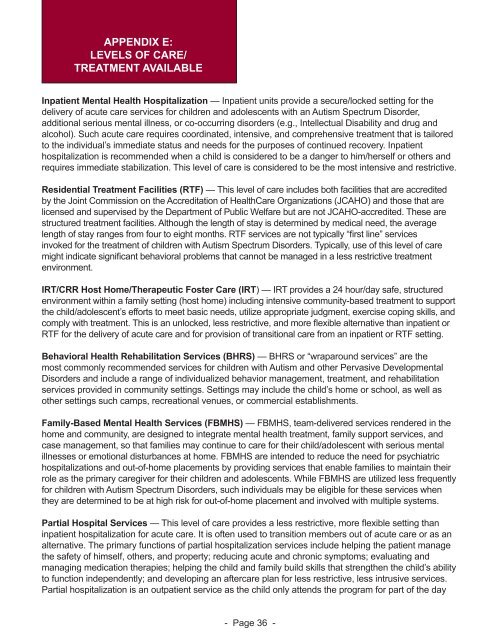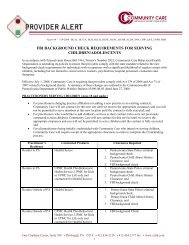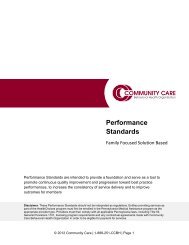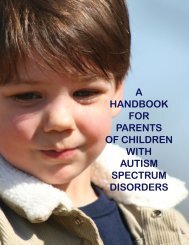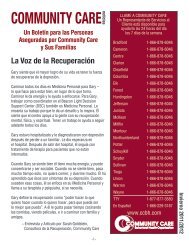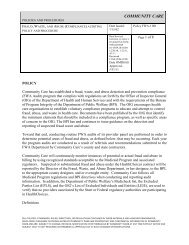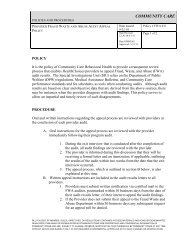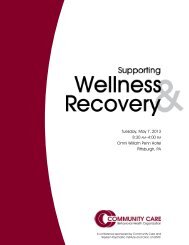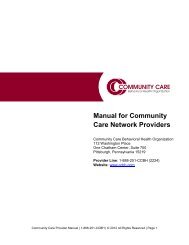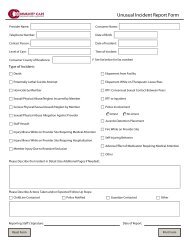a handbook for parents of children with autism spectrum disorders
a handbook for parents of children with autism spectrum disorders
a handbook for parents of children with autism spectrum disorders
Create successful ePaper yourself
Turn your PDF publications into a flip-book with our unique Google optimized e-Paper software.
APPENDIX E:<br />
LEVELS OF CARE/<br />
TREATMENT AVAILABLE<br />
Inpatient Mental Health Hospitalization — Inpatient units provide a secure/locked setting <strong>for</strong> the<br />
delivery <strong>of</strong> acute care services <strong>for</strong> <strong>children</strong> and adolescents <strong>with</strong> an Autism Spectrum Disorder,<br />
additional serious mental illness, or co-occurring <strong>disorders</strong> (e.g., Intellectual Disability and drug and<br />
alcohol). Such acute care requires coordinated, intensive, and comprehensive treatment that is tailored<br />
to the individual’s immediate status and needs <strong>for</strong> the purposes <strong>of</strong> continued recovery. Inpatient<br />
hospitalization is recommended when a child is considered to be a danger to him/herself or others and<br />
requires immediate stabilization. This level <strong>of</strong> care is considered to be the most intensive and restrictive.<br />
Residential Treatment Facilities (RTF) — This level <strong>of</strong> care includes both facilities that are accredited<br />
by the Joint Commission on the Accreditation <strong>of</strong> HealthCare Organizations (JCAHO) and those that are<br />
licensed and supervised by the Department <strong>of</strong> Public Welfare but are not JCAHO-accredited. These are<br />
structured treatment facilities. Although the length <strong>of</strong> stay is determined by medical need, the average<br />
length <strong>of</strong> stay ranges from four to eight months. RTF services are not typically “first line” services<br />
invoked <strong>for</strong> the treatment <strong>of</strong> <strong>children</strong> <strong>with</strong> Autism Spectrum Disorders. Typically, use <strong>of</strong> this level <strong>of</strong> care<br />
might indicate significant behavioral problems that cannot be managed in a less restrictive treatment<br />
environment.<br />
IRT/CRR Host Home/Therapeutic Foster Care (IRT) — IRT provides a 24 hour/day safe, structured<br />
environment <strong>with</strong>in a family setting (host home) including intensive community-based treatment to support<br />
the child/adolescent’s ef<strong>for</strong>ts to meet basic needs, utilize appropriate judgment, exercise coping skills, and<br />
comply <strong>with</strong> treatment. This is an unlocked, less restrictive, and more flexible alternative than inpatient or<br />
RTF <strong>for</strong> the delivery <strong>of</strong> acute care and <strong>for</strong> provision <strong>of</strong> transitional care from an inpatient or RTF setting.<br />
Behavioral Health Rehabilitation Services (BHRS) — BHRS or “wraparound services” are the<br />
most commonly recommended services <strong>for</strong> <strong>children</strong> <strong>with</strong> Autism and other Pervasive Developmental<br />
Disorders and include a range <strong>of</strong> individualized behavior management, treatment, and rehabilitation<br />
services provided in community settings. Settings may include the child’s home or school, as well as<br />
other settings such camps, recreational venues, or commercial establishments.<br />
Family-Based Mental Health Services (FBMHS) — FBMHS, team-delivered services rendered in the<br />
home and community, are designed to integrate mental health treatment, family support services, and<br />
case management, so that families may continue to care <strong>for</strong> their child/adolescent <strong>with</strong> serious mental<br />
illnesses or emotional disturbances at home. FBMHS are intended to reduce the need <strong>for</strong> psychiatric<br />
hospitalizations and out-<strong>of</strong>-home placements by providing services that enable families to maintain their<br />
role as the primary caregiver <strong>for</strong> their <strong>children</strong> and adolescents. While FBMHS are utilized less frequently<br />
<strong>for</strong> <strong>children</strong> <strong>with</strong> Autism Spectrum Disorders, such individuals may be eligible <strong>for</strong> these services when<br />
they are determined to be at high risk <strong>for</strong> out-<strong>of</strong>-home placement and involved <strong>with</strong> multiple systems.<br />
Partial Hospital Services — This level <strong>of</strong> care provides a less restrictive, more flexible setting than<br />
inpatient hospitalization <strong>for</strong> acute care. It is <strong>of</strong>ten used to transition members out <strong>of</strong> acute care or as an<br />
alternative. The primary functions <strong>of</strong> partial hospitalization services include helping the patient manage<br />
the safety <strong>of</strong> himself, others, and property; reducing acute and chronic symptoms; evaluating and<br />
managing medication therapies; helping the child and family build skills that strengthen the child’s ability<br />
to function independently; and developing an aftercare plan <strong>for</strong> less restrictive, less intrusive services.<br />
Partial hospitalization is an outpatient service as the child only attends the program <strong>for</strong> part <strong>of</strong> the day<br />
- Page 36 -


